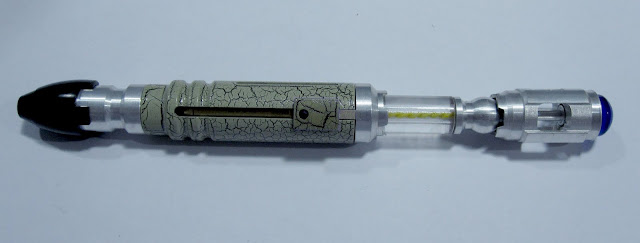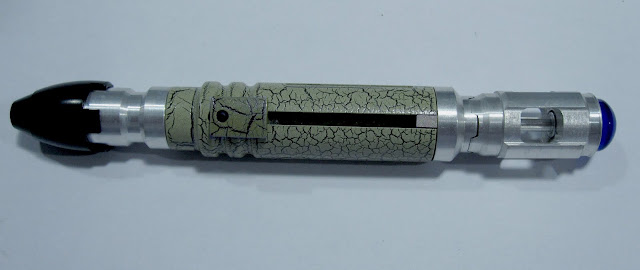Phez made this observation about my prop:
"Like why is the head connected to the slide totally different than the screen used ones? Even the plastic background piece this is based on is not like that."
Now I like to think my grasp of the English language is far from tenuous but even a wordsmith of my calibre cannot decipher this garbled mess.
However, Phez has made himself clearer.
He subsequently posted this:
"You guys I am not trying to debunk the guys props. He did a great job on it period. I am dropping the photo proof question because it just does not matter. Here is what I am talking about. The tube that goes up the center of the headpiece one size all the way through. In the photo (and all of them I have seen) all around where the tube goes into the tip (and the body end of the head) is a flat surface. If you look at the replica on the first page of this thread you can see the rings where two sides of that pin are bigger where they screw in from the center post on the bottom and go into the tip of the unit.
It is a small detail and was probably just another design decision no doubt like the slider was so you could replace the LED or something. Not a big deal."
It's a decent enough question which I have covered previously, but I'll cover it again with much the same patience that a remedial kid needs.
Ok. The construction on mine is based on the Penny Howarth made hero prop. The prop picture above is the Aztec 'static' prop (it actually wasn't that static, it can slide in and out).
In any case, the way my prop fits together is that the LED sits in an LED holder and the head cage slides on and screws into the ball. This featured a circular join at the base of the head recess below the centre pipe.
Look here at a shot of the Tennant prop from the Visual Dictionary:
The pencil is pointing to the join I refer to. There is also a join on the upper part of the inner recess too. This is where the ball join screws into the emitter head cage. Here is the head without the emitter cage screwed in showing the LED holder:
Mr Jedibugs also reminded me of something else that will confirm I am correct in my observations and engineering:
This picture clearly shows the large upper aperture where an LED holder, such as on mine will fit into. This aperture is clearly larger than the diameter of the central pipe.
Ok, some caveats here. I do not know if ALL the props including the Tennant one had this construction (but based on the above DK pic I know at least one did). I suspect that the hero props do as there were only 4 to 6 heads (including the 3 Aztec heads that I know DO NOT have this construction) ever made that were constantly recycled and mounted onto different bodies. I also cannot say 100% this construction is actually correct as I never took apart the prop. I can tell you that externally, my replica looks identical with the correct joins, the rest I engineered using common sense principles of design, including the LED holder.
For next week's lesson Mr Phez, please bring along some chewing gum. I'll teach you how to chew it.
Edit: Einstein Phez has tried to argue his case by presenting the following two pictures as proof of the absence of the LED holder:
Firstly, the top picture can be discounted as it is the Aztec prop. The second pic is the prop I had access to.
Let me state that the tolerance between the LED holder and the head cage is tiny. Thousandths of a millimeter. The seam is virtually invisible and that close tolerance has practical problems such as galling and thermal expansion (which I solved by making the tolerance larger). Having stated that, let's look at the pics.
Here's a closeup of the head of the second pic:
Can't see anything? Look a bit closer:
See it now? If not, here's the same pic with contrast turned up:
See what I mean? Look and all shall be revealed. I think this what you call, getting 'pwned', lolololol.








































.jpg)
.jpg)
